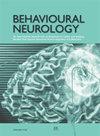血浆同型半胱氨酸升高与帕金森病轻微幻觉:一项横断面研究
IF 2.7
4区 医学
Q2 CLINICAL NEUROLOGY
引用次数: 5
摘要
目的轻微幻觉是帕金森病(PD)最常见的精神症状,对帕金森病的临床和预后具有重要意义。据报道,血浆同型半胱氨酸(Hcy)可以预测帕金森病的预后;Hcy是否与MH有关尚不清楚。目的探讨PD和MH患者的Hcy水平及其相关因素。方法采用横断面研究方法,纳入PD患者99例,MH患者34例,无幻觉患者65例。比较有幻觉和无幻觉患者的临床和人口学资料。并分析了hcy相关的临床因素。结果MH患者血浆Hcy水平明显高于无幻觉患者,且男性明显高于女性。当根据左旋多巴当量日剂量和疾病持续时间进行分组时,也观察到差异。高Hcy浓度与MH患者的一些症状相关,包括运动功能障碍和非运动症状,如胃肠道症状、血管硬化、睡眠/疲劳、视觉空间/执行功能差。结论MH患者血浆Hcy浓度高于其他人群,Hcy与MH患者的某些运动和非运动症状相关,Hcy可能是MH的标志物,对PD有重要的治疗意义。本文章由计算机程序翻译,如有差异,请以英文原文为准。
Elevation of Plasma Homocysteine and Minor Hallucinations in Parkinson's Disease: A Cross-Sectional Study
Purpose Minor hallucinations (MHs) are the most common psychotic phenomena in Parkinson's disease (PD), and it has important clinical and prognostic implications in PD. Plasma homocysteine (Hcy) has been reported to predict the outcome of PD; whether or not Hcy is associated with MH is not known. We aim to investigate the Hcy level and related factors in patients with PD and MH. Methods We conducted a cross-sectional study and included 99 patients with PD, 34 with MH, and 65 without any hallucinations. The clinical and demographic data of the patients with and without hallucinations were compared. Hcy-related clinical factors were also analyzed. Results The plasma Hcy level was higher in MH patients than in patients without hallucinations, and the result was more pronounced in male patients than in female patients. Differences were also observed when the groups were divided on the basis of levodopa equivalent daily dose and disease duration. The high Hcy concentration was correlated with some symptoms in patients with MH, including motor dysfunction and nonmotor symptoms, such as symptoms of the gastrointestinal tract, angiocarpy, sleep/fatigue, and poor visuospatial/executive function. Conclusions Results indicated a higher plasma Hcy concentration in MH patients than in their counterparts and revealed that Hcy is associated with certain motor and nonmotor symptoms in patients with MH. Hcy may be a marker of MH and have important therapeutic implications in PD.
求助全文
通过发布文献求助,成功后即可免费获取论文全文。
去求助
来源期刊

Behavioural Neurology
医学-临床神经学
CiteScore
5.40
自引率
3.60%
发文量
52
审稿时长
>12 weeks
期刊介绍:
Behavioural Neurology is a peer-reviewed, Open Access journal which publishes original research articles, review articles and clinical studies based on various diseases and syndromes in behavioural neurology. The aim of the journal is to provide a platform for researchers and clinicians working in various fields of neurology including cognitive neuroscience, neuropsychology and neuropsychiatry.
Topics of interest include:
ADHD
Aphasia
Autism
Alzheimer’s Disease
Behavioural Disorders
Dementia
Epilepsy
Multiple Sclerosis
Parkinson’s Disease
Psychosis
Stroke
Traumatic brain injury.
 求助内容:
求助内容: 应助结果提醒方式:
应助结果提醒方式:


